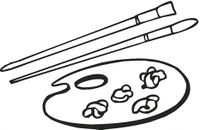Difference between revisions of "Category:Nero--art (subject)"
| (3 intermediate revisions by the same user not shown) | |||
| Line 1: | Line 1: | ||
[[File:Art2.jpg|thumb|200px|[[Art]] (Home Page)]] | |||
[[File:Nero Waterhouse.jpg|thumb|200px|[[Nero]] (Home Page)]] | |||
'''Works of [[art]] related to [[Nero]]''' | '''Works of [[art]] related to [[Nero]]''' | ||
<''Fiction'' : [[Nero (literature)]] -- [[Nero (music)]] -- [[Nero (cinema)]]> | |||
==Overview== | |||
In spite of his popularity in literature and music, very rarely Nero appears in works of art. Christian iconography ignores him, if not in the (apocryphal) episode of the dispute between [[Peter]] and [[Simon Magus]]. Two major (and quite influential) paintings appeared at the end of the 19th century. The first, by Polish artist [[Henryk Siemiradzki]] (1877), showed Nero as a sadistic ruler in persecuting the early church, thus preparing the path to the success of ''Quo Vadis?'' (1895). The second, by British artist [[John William Waterhouse]] (1878) focused instead on his more intimate dimension of insecurity and trouble after having ordered the killing of his mother. Both paintings consolidated the myth and the image of Nero's "madness." | |||
Latest revision as of 01:30, 9 June 2017


<Fiction : Nero (literature) -- Nero (music) -- Nero (cinema)>
Overview
In spite of his popularity in literature and music, very rarely Nero appears in works of art. Christian iconography ignores him, if not in the (apocryphal) episode of the dispute between Peter and Simon Magus. Two major (and quite influential) paintings appeared at the end of the 19th century. The first, by Polish artist Henryk Siemiradzki (1877), showed Nero as a sadistic ruler in persecuting the early church, thus preparing the path to the success of Quo Vadis? (1895). The second, by British artist John William Waterhouse (1878) focused instead on his more intimate dimension of insecurity and trouble after having ordered the killing of his mother. Both paintings consolidated the myth and the image of Nero's "madness."
Pages in category "Nero--art (subject)"
The following 4 pages are in this category, out of 4 total.